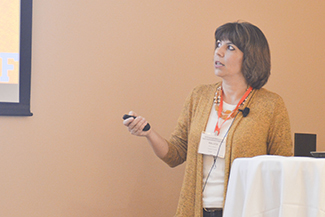Selecting for Thermotolerance
Researchers are studying cattle to increase their thermotolerance.
by Kaci Foraker, editorial intern
BROOKINGS, S.D. (June 19, 2019) — Raluca Mateescu has been working at the University of Florida with Bos indicus and Angus cattle to analyze their responses to heat stress. At the 2019 Beef Improvement Federation symposium in Brookings, S.D., she presented her most recent findings.
“If we look at the cattle populations around the world, probably around 80% are Bos indicus-influenced,” said Mateescu. “This is not surprising, because we know there are a number of advantages Bos indicus have. What we see over and over is when we do use Bos indicus in a crossbreeding program, they produce cattle that reproduce and gain well and live long with insect-resistance characteristics.”

Raluca Mateescu
Within each breed group there was a large amount of variation between individual animals, observed Raluca Mateescu, University of Florida, of research analyzing heat tolerance of Brahman and Angus cattle. Variation will allow selection for those traits.
More than 50% of global cattle are in tropical or subtropical climates, so selecting those that better adapt to elevated temperatures will increase productivity overall, Mateescu said.
Cattle can maintain their body temperature within normal limits in hot and humid environments by moderating their heat production or by increasing their heat exchange. Cattle decrease heat production by modulating their metabolic rate, which means they will lower their feed intake and ultimately negatively affect production. To increase heat exchange, a cow will increase blood flow to her skin. This will allow heat to leave the body via evaporation and has limited effect on feed intake. Therefore, Mateescu has focused her research on maintaining body temperature within normal limits through heat exchange while leaving heat-production levels alone.
Factors
In one study, she analyzed three important factors that greatly affect an animal’s body temperature. The first aspect was coat color. Another characteristic was the length and diameter of the topcoat and undercoat. The final consideration was size and position of sweat glands.
“There is a significant effect as you move from 100% Angus cattle, which have the longer topcoat and longer undercoat, to Brahman cattle, which will have the shortest ones,” said Mateescu.
Within each breed group there was a large amount of variation between each individual animal. She noted that variation is beneficial, because selection can be made for those traits.
Heat load
At the University of Florida, a research population was split into six groups of cattle based on their breeding influence of 100% Brahman to 100% Angus. Approximately 300 heifers’ internal body temperature was measured over a three-day period via a CIDR device that intermittently recorded temperatures.
“It is very interesting to note that Brahman were really able to maintain their body temperature much lower throughout the day, right under 39° Celsius,” Mateescu said. “Actually, above 39° Celsius, we start seeing some negative effects, especially relating to reproduction.”
The internal temperatures of the Angus cattle started peaking really early during the day, Mateescu shared. “There are major differences in how they respond to the environmental temperature and humidity.”
Mateescu said she hopes to use thermotolerance for more than finding cattle that can survive in hot climates. She wants to find those that will thrive and be superior in productivity.
“Genomic tools, if we can develop them for this purpose, will offer us a sustainable approach, which is also energy-efficient, to meet this challenge that is in front of us in terms of feeding more people with our product,” said Mateescu, “and continue to do so in a world that is getting hotter and hotter every year.”
The 2019 BIF Annual Convention was hosted by South Dakota State University and the South Dakota Beef Breeds Council June 18-21 at the University Comfort Suites and Convention Center in Bookings. ANGUS MEDIA® provides comprehensive online coverage of the event at www.BIFconference.com. Visit the Newsroom for summaries, proceedings, PowerPoints, video and/or audio of the sessions and the Awards page for announcements and photos of award winners.
Editor’s Note: This summary was written under contract or by staff of ANGUS MEDIA®. Through an agreement with the Beef Improvement Federation,
we encourage reprinting of the articles to those who will adhere to the
reprint guidelines available on this site. Please review those
guidelines or contact Shauna Rose Hermel,
editor, at 816-383-5270. PowerPoints are posted with permission of the
presenter and may not be reproduced in whole or in part without the
express permission of the presenter. We welcome educational venues and
cattlemen to link to this site as a service to their audience.
For questions about this site, or to notify us of broken links, click here. Look for additional coverage in the Angus Journal, the Angus Beef Bulletin, the Angus Journal Daily, the Angus Beef Bulletin EXTRA and Angus TV.


